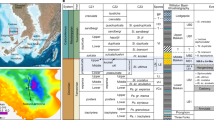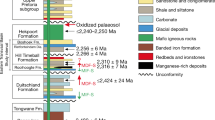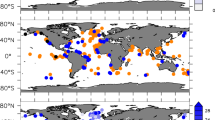Abstract
Replying to: K. Grey & C. R. Calver Nature 450, doi: 10.1038/nature06360 (2007).
Calver and Grey1 point out the difficulties of relating the Australian acritarch record to the global record of environmental change. This results from the lack of documented stratigraphic sections that have overlapping chronologies of both acritarch evolution and global chemostratigraphic proxies, such as δ13Ccarb, and we agree that coupled records are required to confirm our hypothesis2. Until such records exist, any correlations between Australian acritarch-bearing strata and strata containing records of global secular variations in δ13Ccarb are necessarily tenuous. This uncertainty, however, does not affect the principal conclusion of our paper, which emphasizes the evidence for sequential chemical oxidation of the Ediacaran ocean. Our inferred correlation between chemical oxidation and biological evolution is supported by subsequent results on strata containing strong geochronologic tie-points and a robust biostratigraphic and chemostratigraphic record3,4.
This is a preview of subscription content, access via your institution
Access options
Subscribe to this journal
Receive 51 print issues and online access
$199.00 per year
only $3.90 per issue
Buy this article
- Purchase on Springer Link
- Instant access to full article PDF
Prices may be subject to local taxes which are calculated during checkout
Similar content being viewed by others
References
Grey, K. & Calver, C. R. Ediacaran oxidation and biotic evolution. Nature 10.1038/nature06360 (2007)
Fike, D. A., Grotzinger, J. P., Pratt, L. M. & Summons, R. E. Oxidation of the Ediacaran Ocean. Nature 444, 744–747 (2006)
Canfield, D. E., Poulton, S. W. & Narbonne, G. M. Late neoproterozoic deep ocean oxygenation and the rise of animal life. Science 315, 92–95 (2007)
Yin, L. et al. Doushantuo embryos preserved inside diapause egg cysts. Nature 446, 661–663 (2007)
Calver, C. R. Isotope stratigraphy of the Ediacarian (Neoproterozoic III) of the Adelaide Rift Complex, Australia, and the overprint of water column stratification. Precambr. Res. 100, 121–150 (2000)
Grey, K. Ediacaran palynology of Australia Mem. 31 (ed. Laurie, J. R.) 52 (Association of Australasian Paleontologists, Canberra, 2005)
Walter, M. R., Veevers, J. J., Calver, C. R., Gorjan, P. & Hill, A. C. Dating the 840–544 Ma Neoproterozoic interval by isotopes of strontium, carbon, and sulfur in seawater, and some interpretative models. Precambr. Res. 100, 371–433 (2000)
Author information
Authors and Affiliations
Rights and permissions
About this article
Cite this article
Fike, D., Grotzinger, J., Pratt, L. et al. Fike et al. reply. Nature 450, E18 (2007). https://doi.org/10.1038/nature06361
Published:
Issue Date:
DOI: https://doi.org/10.1038/nature06361
Comments
By submitting a comment you agree to abide by our Terms and Community Guidelines. If you find something abusive or that does not comply with our terms or guidelines please flag it as inappropriate.



